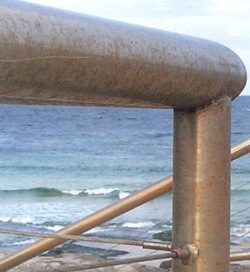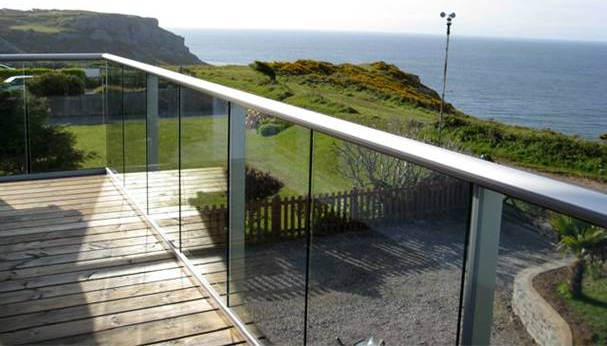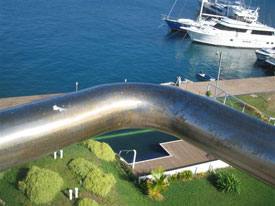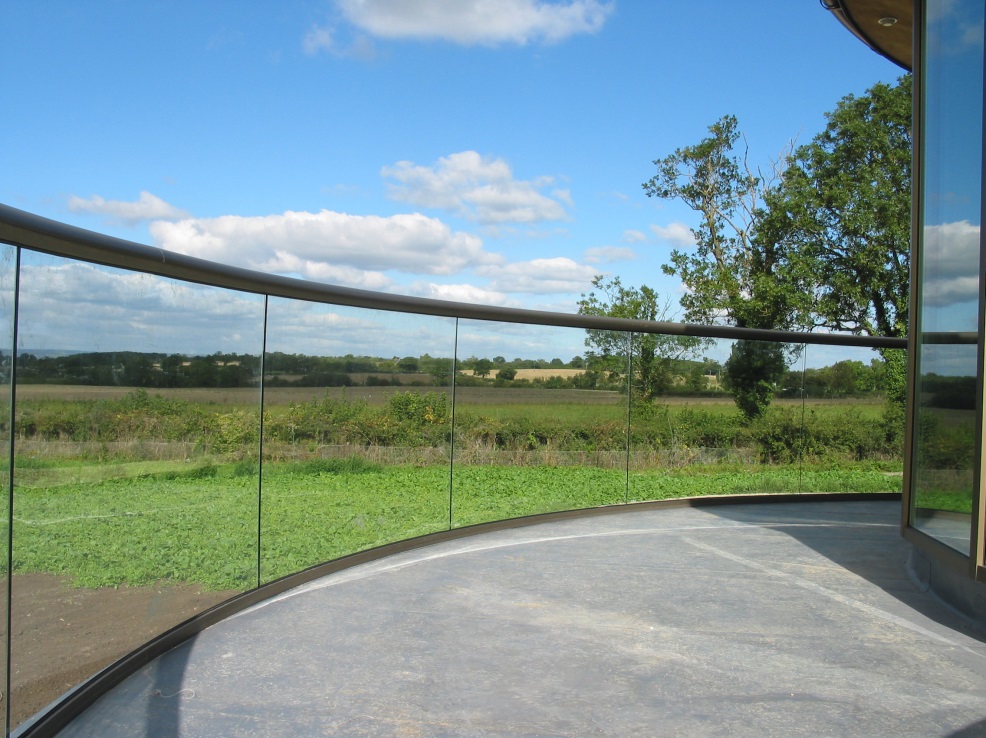Stainless Steel – Does it rust? Is it stainless? Or does it just stain less…
Glass Balustrades | Juliet Balconies | Galleries | Articles | Case Studies
Making an informed decision
 Example of rust on handrails
Example of rust on handrails
To make an informed decision on which materials to choose for handrails and structure when ordering your glass balustrade, it is important to understand the advantages of the type of material that is used.
Important factors to take into account when choosing either stainless steel railings, stainless steel balustrades, aluminium railings or aluminium balustrades are:
- Longevity - i.e. corrosion resistance
- Maintenance requirements
- Aesthetics and finish quality
- Price
- Eco rating - i.e. how "green" is the use of the product?
The information below has been compiled to help improve your knowledge on stainless steel, why it needs regular cleaning and how it compares to the Balcony Systems Balustrade.
Stainless steel railings, stainless steel handrails, stainless steel balustrades etc.
A bit of history first
Stainless steel was discovered by Harry Brearley in England in 1913. Brearley discovered it while doing an experiment of increasing the levels of chromium. Based on his experiment, a 12% of chromium makes the steel resistant to corrosion caused by acid. In 1920, there were two stainless steel types that were found to be useful and these are the martensitic stainless steel and the austenitic stainless steel.
Stainless steel is also known as a steel alloy that generally has at least 11.5% of chromium content. This material has certain qualities that do not stain and rust as compared to ordinary metals. When the alloy grade and type are not completely identified, it is known as corrosion resistant steel.
Stainless steel has different grades and surface finishing. It has around 150 grades. Fifteen of these grades are widely used. These types are produced into coils, plates, sheets, wires and tubing. Due to the qualities of stainless steel, it made its way as one of the mainly used steel in many commercial applications.
Use in Handrails and Railings
Stainless steel handrails and stainless steel railings are very popular and generally considered one of the most preferred materials for balconies in marine areas. They are considered to last years, same may say decades. This is true to some degree but there are some real pitfalls in this that, if not known or properly avoided, disappoint both the end user and manufacturer.
Almost everyone that produces or manufactures stainless steel products finds that they rust or stain occasionally. This really upsets purchasers since they have paid for "stainless". On some occasions I have heard stainless steel fabricators state that “Stainless” means that it stains less; this is maybe a test of the English language but a rather more truthful description.

Balcony Systems stainless steel handrail
How and when do stainless steel railings become vulnerable to corrosion and how can they be protected?
This is a good question for architects, designers and specifiers of materials for buildings
To address this question, Hitchiner has tested various conditions that cause stainless steels to rust. Here's a synopsis of the factors at play in stainless steel corrosion and the results and conclusions that can be drawn from Hitchiner's testing program.
Stainless Steel Corrosion
There are two basic types of stainless steel (1) highly corrosion resistant, nickel-chromium austenitic steels and (2) less corrosion resistant ferritic and martensitic steels. (Side note - for special purposes, there are also duplex stainless steels, a mixture of the two structures).
Basically, the formation of a passive surface layer of chromium oxide on stainless steel handrails protects the metal from corrosive media in everyday usage and surroundings. The alloys' resistance to various chemical solutions is too complex to cover fully here; Results from testing most stainless steel alloys extensively in atmospheres around Europe & the United States, show that, in a few years at most, both rust and white corrosion products form on all stainless steels, even those that were perfectly clean at the beginning of the tests.
Many different mechanisms can play a role in forming these corrosion products. In some cases, redeposition after dissolution from the alloy surface leaves ions on the steel's surface. With the right conditions of heat and humidity, these ions combine with oxygen and develop a corrosion product. Redeposition of iron ions leads to rust spots; redeposition of chromium ions leaves a deposit of chromium oxide, indicated by white spots having a matte finish on the polished steel.
Stainless steel contamination issues
A particular area of severe importance and probably the area most prone to "rusting" or staining of stainless steel handrails is where welds are incorporated, causing iron contamination. Also the use of non-stainless steel processing and handling equipment when fabricating, cutting or processing stainless steel is a frequent source of contamination. Non-metallic contact materials and vacuum lifting equipment should be used to avoid process contamination. Working in 'mixed-metal' fabrication shops, without taking segregation and cleaning precautions can result in such contamination.
Cutting of stainless steel handrails or grinding debris from non-stainless steels should not be allowed to settle on stainless steel items. As soon as any of this contamination becomes wet, rust staining will result. Once contaminated the metals will suffer corrosion and possibly even worse, a metallic reaction between the two metals.
Regular Cleaning
 'Tea stain' on stainless steel handrail
'Tea stain' on stainless steel handrail
It was also found that if the stainless steel handrails and stainless steel railings are kept regularly clean, it will not form either corrosion product for many, many years.
This stresses that regular cleaning of the stainless steel balustrades is essential. Handling or fabricating stainless steel on equipment, using tools also used for non-stainless steels should be avoided.
Recycling of stainless steel
When considering the “green”, or eco side of choosing stainless steel, recycling is an important factor. There exist well systems to collect and recycle stainless steel. This scrap and parts remaining from the production, manufacturing and cutting of stainless steel parts and products. These and reclaimed stainless steel will be recycled and most stainless steel in circulation contains at least half recycled materials within them.
This ready recyclability is one of the contributions which stainless steel makes to sustainable development.
Comparative costs
Stainless steel and glass balustrades, and in particular when 316 (marine grade) stainless alloy is used are relatively expensive and cost between £500 to £800 a metre.
Stainless steel railing are very aesthetic and can be finished is various ways from a matt finish to a mirror polish. Many stainless steel balustrades require posts and to connect the glass use glass clamps which are considered unsightly by some purchasers.
In recent years a lot of “cheap” stainless steel systems have entered the UK, mostly sourced in Asia. On one hand this has made some stainless steel systems relatively inexpensive but really at the expense of quality. Beware of “cheap stainless steel” it may end up being expensive to replace.

Balcony Systems curved balustrade
Balcony Systems Royal Chrome Finish
Balcony Systems has developed a proprietary anodised fished called "Royal Chrome" which eliminates pretty much all the problems mentioned above.
As an an example of the durability of this finish read the linked case study of a sea side project with extensive glass balustrades on the sea front which we revisited seven years after installation of the railings which were finished in the Royal Chrome anodising.
Click here to see how Balcony Systems' Royal Chrome balustrading has fared by the sea seven years on







